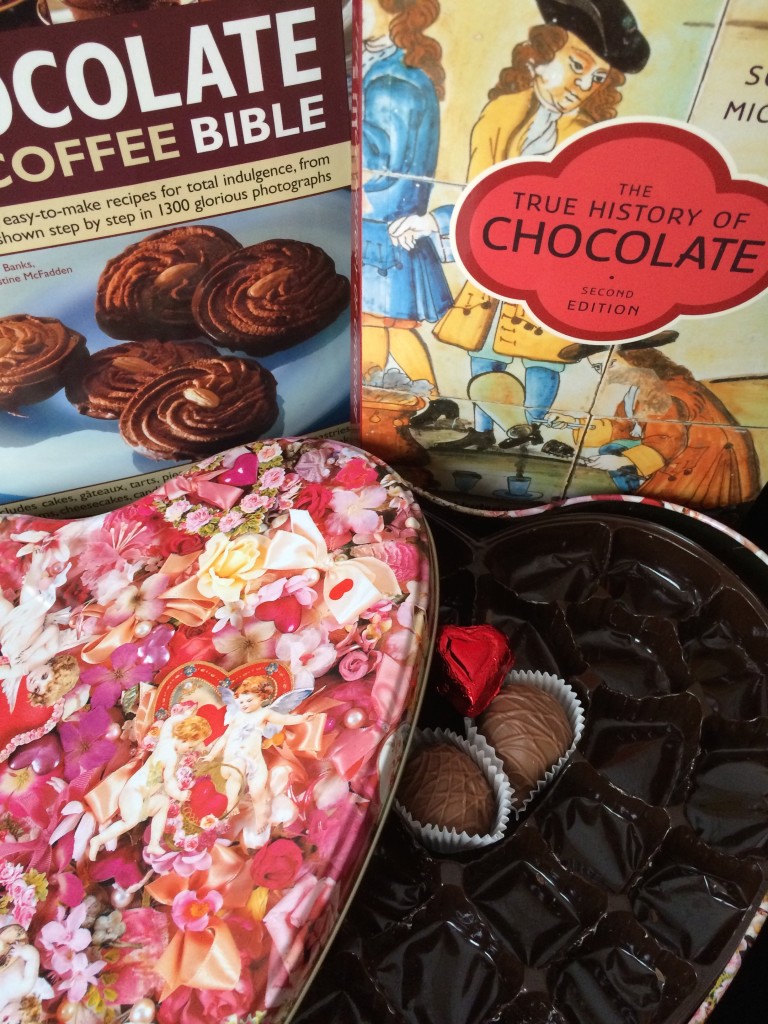 The irresistible power of chocolate was clearly evident after our two-and-a half-year-old granddaughter toddled into the kitchen and in no time at all spotted the milk chocolate Lindt balls on the kitchen counter. Reaching up high on her tiptoes she matter of factly said, “I need chocolate.”
The irresistible power of chocolate was clearly evident after our two-and-a half-year-old granddaughter toddled into the kitchen and in no time at all spotted the milk chocolate Lindt balls on the kitchen counter. Reaching up high on her tiptoes she matter of factly said, “I need chocolate.”
Though it has been written that more women (and obviously little girls) than men “need” chocolate, one learns in The True History of Chocolate that it was a luxury, “an elite beverage”, reserved only for kings and noblemen and their military who “needed” it the most. The Aztecs believed that chocolate had “energy-boosting properties”…and was given to their warriors to “fortify them on military campaigns.”
How interesting to learn that these ancient people, the Mayan in AD 300 followed by the Aztecs in AD 900, were not much different from us with their “stashes” of chocolate: the “sheer amount of cacao” they stashed in royal storehouses was “astounding.”
 “These depositories shared some of the characteristics of Fort Knox, on the one hand, and Louis XIV’s wine cellars, on the other” (The True History of Chocolate).
“These depositories shared some of the characteristics of Fort Knox, on the one hand, and Louis XIV’s wine cellars, on the other” (The True History of Chocolate).
Indeed, chocolate has quite a long and evolved history as is evidenced in both Sophie and Michael Coe’s book, The True History of Chocolate and The Chocolate and Coffee Bible. While Sophie* and Michael Coe’s book offers an extensive, fascinating and scholarly history of the ancient civilizations in which the history of chocolate resides, The Chocolate and Coffee Bible is closer to an encyclopedia filled with recipes and easily accessible information on both chocolate and coffee.
As the authors of the chocolate bible book write in the introduction: “Hardly a day goes by in most of our lives without sipping a mood-lifting cup of coffee, or nibbling on an indulgent, comforting chocolate treat.” In this “indispensable” book, it is interesting to learn that “although chocolate has its origins in South America and the birthplace of coffee was…in Africa…many aspects of their history run parallel…and are interwoven touching every aspect of society, establishing vital roles in religion, medicine, politics, economics and culture.”
These two “legendary foods” have “known conflict, fueled armies, made fortunes, nourished many nations, caused political unrest and encouraged much social interaction.”
Below are some of the fortunes that were made in America when chocolate arrived on its shores around 1765:
 Baker’s Chocolate
Baker’s Chocolate
The first American chocolate factory set up in 1765 along the banks of the Neponset River in Massachusetts by Dr. James Baker and John Hannon, becoming The Walter Baker Co. in 1780 by Baker’s grandson, still producing quality chocolate today.
The Hershey Chocolate Factory
Established by Mennonite Milton Hershey (1857-1945) in 1884 in what became Hershey, PA. Considered a “paternalistic capitalist” he was dubbed the “Henry Ford” of the American chocolate industry for bringing mass production to the chocolate industry.
Domingo Ghirardelli
An Italian confectioner who had South American connections. He established the “Ghirardelli’s California Chocolate Manufactory” in 1856 in San Francisco hoping to capitalize on the needs of the goldrush pioneers.
Formula for Quality Chocolate
56-70% cacao solids, to include 31% cacao butter
29-43% finely ground sugar
1% lecithin and pure vanilla extract
Formula for Mass-Produced Milk Chocolate
11% cacao solids
3% vegetable fat
20% milk solids
65% sugar
1% lecithin and synthetic vanillin
*Of interest:
Sophie Coe, the daughter of the noted Russian-American geneticist Theodosius Dobshansky, had a doctorate in anthropology and brought a “scientific rigor to her scholarship and insisted that nothing be presented as fact that could not be backed up by solid data.” She was a great cook of Russian cuisine and her “remarkable cookbook library” resides at Radcliffe College in Cambridge, Massachusetts.
Oh my goodness – I love everything about this post! I think the ‘need’ for chocolate can be deeply engrained in the human psyche. Excellent post!